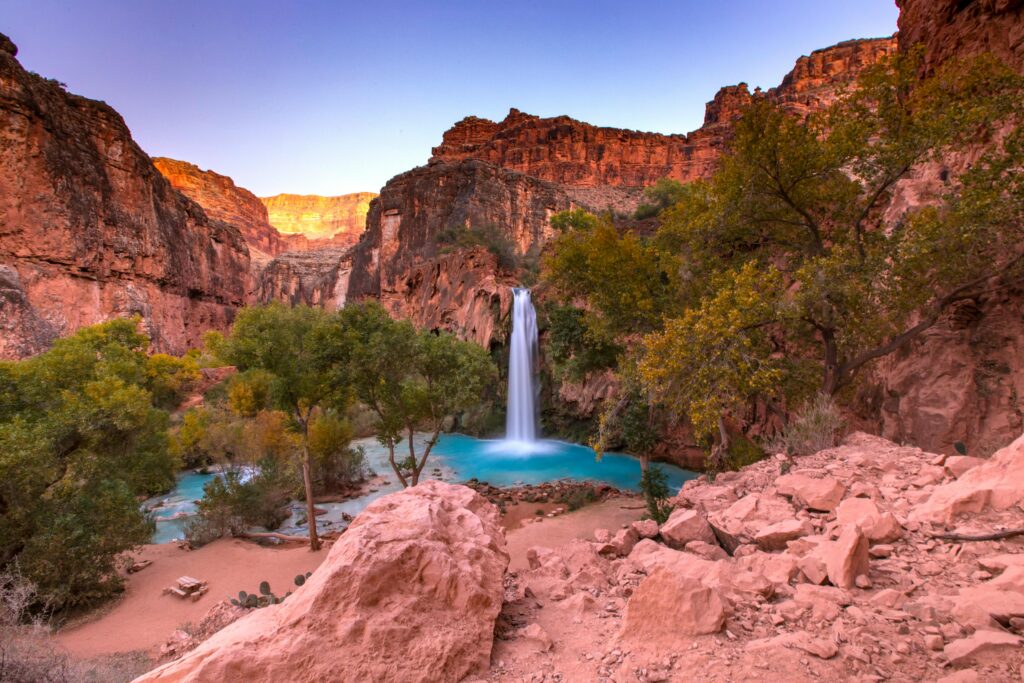Tucked away in a remote side canyon of the Grand Canyon, Havasu Falls is a shimmering turquoise waterfall that looks almost too beautiful to be real. Its vibrant blue-green waters, cascading 30 meters (100 feet) over orange-red rocks into travertine pools, make it one of the most photogenic places on Earth.
Lees verder: Havasu Falls: Hidden Paradise in the Grand CanyonBut reaching Havasu Falls isn’t easy — it requires careful planning, hiking deep into tribal lands, and securing hard-to-get permits. Here’s your ultimate 2025 guide to visiting Havasu Falls: from planning and permits to hiking tips and the best time to go.
What Makes Havasu Falls Special?
Located on the Havasupai Indian Reservation in Arizona, Havasu Falls is the crown jewel of the Havasu Creek, which flows through Havasu Canyon before joining the Colorado River at the Grand Canyon. The intense turquoise color comes from high concentrations of calcium carbonate, which coats the creek bed and reflects sunlight in a dazzling display.
Surrounding the falls are lush cottonwood trees, towering canyon walls, and natural travertine pools perfect for swimming. The contrast of vivid water, red rock, and greenery creates a surreal, tropical oasis in the middle of the Arizona desert.
How to Get to Havasu Falls

Your adventure starts at the remote Hualapai Hilltop, the only road-accessible point to begin the hike. It’s about:
- 4 hours from Flagstaff, AZ
- 5 hours from Las Vegas, NV
- 5 hours from Phoenix, AZ


- Distance: approx. 10 miles (16 km) one-way from Hualapai Hilltop to the campground.
- Elevation: the hike descends ~1,800 feet (550 meters) from the trailhead to Supai Village.
- Trail: mostly exposed, with few shaded sections. The initial switchbacks are steep, followed by a long canyon walk through sand and rocks.
Permit Requirements


- Permits are available exclusively through the official Havasupai Reservations website: HavasupaiReservations.com.
- Permits typically go on sale in February for the entire year and sell out almost immediately — within hours.
- Reservations cover a minimum 3-night stay; day hikes are not allowed.

- Approx. $395–$445 per person for the 3-night package, including camping fees.
Best Time to Visit Havasu Falls




Pro tip: Early spring and fall offer the best conditions for both hiking and swimming.
Must-See Spots Around Havasu Falls
Havasu Creek features five stunning waterfalls, each with its own character:





Camping at Havasu Falls

- Located along Havasu Creek between Havasu Falls and Mooney Falls.
- First-come, first-served sites: you choose your spot upon arrival.
- Facilities: composting toilets, picnic tables, spring-fed drinking water.
- Fires are not allowed; bring a camp stove if you plan to cook.

- Alternative to camping for those who prefer a bed.
- Rooms are basic but comfortable, with bathrooms and air conditioning.
How to Prepare for the Hike




- Backpack with good support.
- Snacks and electrolyte drinks.
- Lightweight sleeping bag.
- Swimsuit, towel, and water shoes for exploring the falls.
- Sunscreen, hat, sunglasses.
- First aid kit, headlamp, and trekking poles (helpful in sand or during river crossings).
Should You Hire a Pack Mule?
The Havasupai Tribe offers pack mule services to carry your gear in and out. Cost in 2025: around $400 round-trip per mule (up to 4 bags total weight ~130 lbs). Ethical concerns about animal welfare have led some visitors to choose self-carrying instead.
Can You Take a Helicopter to Havasu Falls?
Yes — Airwest Helicopters operates flights between Hualapai Hilltop and Supai Village on select days (usually Sundays, Mondays, Thursdays, Fridays). Cost: around $100–$150 per person each way. Note: priority is given to tribal members, and flights are first-come, first-served.
Wildlife & Safety
- Common animals: rattlesnakes, lizards, bighorn sheep, squirrels.
- Flash floods: Always check the weather before descending — storms can cause dangerous, sudden flooding in the narrow canyon.
- Water safety: Don’t dive into pools; rocks and depths are unpredictable.
Photography Tips



Cultural Etiquette & Respect
Havasupai means “people of the blue-green waters.” Remember you are a guest on tribal land:
- Stay on trails; don’t wander into residential areas.
- Ask permission before photographing Havasupai people.
- Pack out all trash.
- Respect local customs and rules — alcohol and drugs are strictly prohibited.
Frequently Asked Questions
How long does the hike to Havasu Falls take?
6–8 hours on average, depending on pace and breaks.
Can you swim at Havasu Falls?
Yes — the pools are perfect for swimming. Water stays around 70°F (21°C) year-round.
Can you do Havasu Falls as a day hike?
No — day trips are not allowed; all visits require overnight permits.
Are dogs allowed?
No pets are allowed on the trail or in the campground.
How to Book Havasu Falls in 2025




Why Havasu Falls is a Once-in-a-Lifetime Experience
From the moment you catch your first glimpse of the turquoise pools cascading through the orange canyon, you’ll know Havasu Falls is unlike anywhere else on Earth. The remote hike, otherworldly beauty, and sense of adventure make it one of America’s most unique and rewarding destinations.
Yes, it’s tough to plan. Yes, the hike is challenging. But those willing to make the effort are rewarded with a paradise that feels like a secret world, hidden away in the heart of the Grand Canyon.
| BeantwoordenDoorsturenReactie toevoegen |




